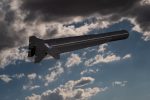Rare imagery has surfaced showing the internal weapons bay of Russia’s Su-57 “Felon” fifth-generation stealth fighter. The photos provide the most detailed look to date at how the aircraft stores and deploys its primary air-to-air weaponry, offering insights into its stealth design philosophy and combat capabilities.
Rare Glimpse into Russia’s Stealth Arsenal
On October 18, 2025, images emerged showing an open internal weapons bay on a Sukhoi Su-57 during ground operations at Akhtubinsk Air Base in southern Russia. The photos—likely taken during a maintenance or test sequence—reveal key structural and functional elements of the bay for the first time in public domain.
The Su-57 features two tandem central fuselage bays designed to house medium-range air-to-air missiles such as the R-77M (NATO reporting name: AA-12B “Adder”). These bays are a critical component of the aircraft’s low observable (LO) design. By storing armament internally rather than on external pylons, radar cross-section (RCS) is minimized—a hallmark feature of fifth-generation fighters like the F-22 Raptor and J-20.
Weapons Configuration and Missile Types
The newly revealed images show what appears to be an R-77M missile loaded in one of the main bays. The R-77M is an upgraded variant featuring an active radar seeker and enlarged dual-pulse motor for extended range—estimated at over 160 km. Its distinctive lattice tail fins are folded to fit within the confines of the bay.
In addition to these central bays, the Su-57 includes two smaller side bays near the wing roots. These are designed for short-range infrared-guided missiles like the R-74M or future K-MD (izdeliye 300) missile. These side bays enable rapid deployment during close-in engagements without compromising stealth.
- Main Bay: Typically houses up to four R-77Ms or similar-sized BVR missiles.
- Side Bays: Accommodate one short-range IR-guided missile each.
- External Hardpoints: Available for non-stealthy loadouts such as bombs or large missiles like Kh-59MK2 or even Kinzhal under certain configurations.
Design Features Supporting Stealth and Agility
The internal weapon carriage system is designed with stealth preservation in mind. The doors are sawtooth-edged to reduce radar reflections when closed. Hinges appear recessed within composite fairings, minimizing drag and signature when opened briefly during launch sequences.
The shape and depth of each bay suggest careful optimization around both aerodynamics and thermal management—key challenges when integrating high-energy weapons into stealth platforms. The internal volume also hints at future compatibility with longer-range or dual-role munitions currently under development by Tactical Missiles Corporation (KTRV).
Status of Su-57 Fleet Integration
The Russian Aerospace Forces (VKS) currently operate approximately two dozen serial-production Su-57s delivered between late 2020 and mid-2025, according to open-source tracking from satellite imagery and Russian MoD statements. While early units were reportedly limited in avionics maturity, newer blocks feature improved mission systems including AESA radar (N036 Byelka), upgraded datalinks, electronic warfare suites, and full weapons integration.
The presence of live or inert R-77Ms inside operational aircraft suggests that beyond visual range (BVR) combat capability is now fully fielded on frontline squadrons. However, there remains no public evidence that long-range hypersonic missiles like Kinzhal have been integrated internally; such payloads likely require external carriage due to size constraints.
Comparison with Western Fifth Gen Fighters
The Su-57’s internal carriage approach mirrors that of its U.S. counterpart—the F-22A Raptor—which carries six AIM-120 AMRAAMs internally along with two AIM‑9X Sidewinders in side bays. China’s J‑20 similarly employs tandem main bays but appears optimized for longer-range standoff roles rather than dogfighting agility.
| Aircraft | Main Bay Capacity | Side Bay Capacity | BVR Missile Type |
|---|---|---|---|
| Su‑57 Felon | 4 × R‑77M | 2 × R‑74M/K-MD | R‑77M (~160+ km) |
| F‑22A Raptor | 6 × AIM‑120D | 2 × AIM‑9X | AIM‑120D (~180 km) |
| J‑20 Mighty Dragon | 4–6 × PL‑15/PL‑21 | N/A or semi-recessed rails | PL‑15 (~200+ km) |
Tactical Implications Going Forward
This first clear view inside a production-standard Su‑57 confirms that Russia has matured its internal carriage system—a key milestone toward full-spectrum fifth-gen capability. While still lagging behind Western counterparts in terms of fleet size and sensor fusion maturity, Moscow appears committed to iterative upgrades through spiral development models akin to U.S. Block upgrades.
The ability to carry advanced BVR missiles internally without compromising stealth enhances survivability in contested airspace—a critical factor given NATO’s expanding IADS footprint near Russian borders. However, real-world performance will depend heavily on pilot training levels, sensor integration maturity, EW resilience against jamming/spoofing threats—and ultimately sortie rates sustained under conflict conditions like those seen in Ukraine or Syria.










